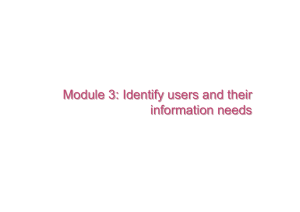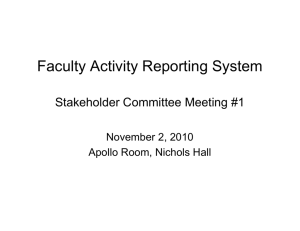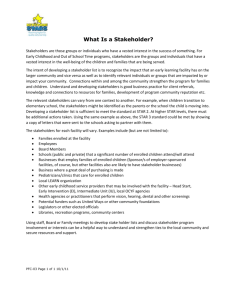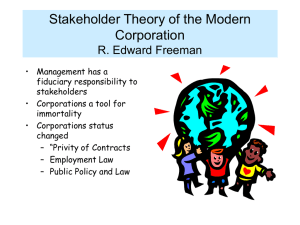KSS Webinar 2 July 31 2013
advertisement
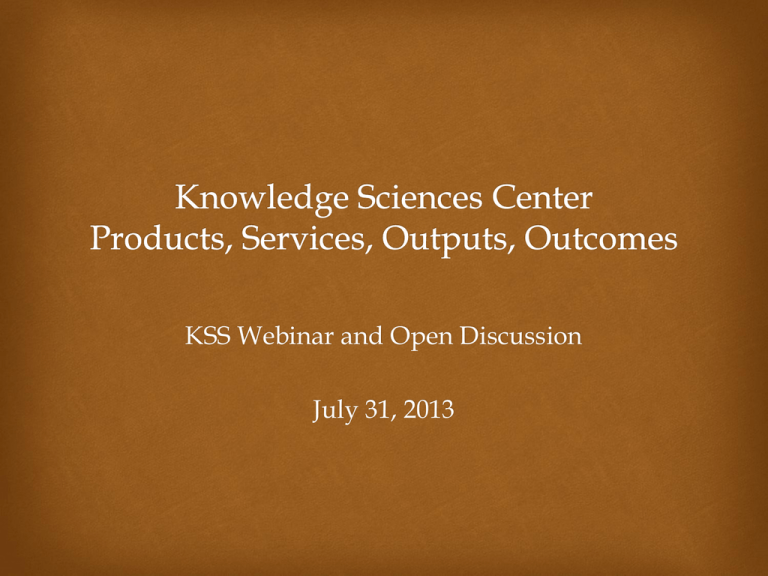
KSS Webinar and Open Discussion July 31, 2013 What we’ve heard so far Last week we discussed best practice models and lessons learned This week we want to hear from you what kinds of products, services the Center should support? What kinds of outputs and outcomes should we aim to achieve? You’ve already made some great suggestions How do we approach this question so that we hear from all of the stakeholder communities? What we’ve heard so far Last week Richard suggested that we consider developing profiles of our five stakeholder groups This was a great idea because we are likely to make assumptions and these assumptions may be based on the wrong perspective And we’re likely to see each stakeholder group as a simple single entity rather than a complex community with diverse interests Should the working groups begin by preparing a profile of the stakeholders they represent? Should this be the basis of defining products and services? Communicating with Stakeholder Groups It follows from Rosemary’s suggestion that we must understand the stakeholder groups before we can talk with them about the value of the Center Their expectations may be comparable to other stakeholder, but they may talk about it in a different context Their expectations may be entirely different Understanding the stakeholders is Task #1 The Academy (Teaching, R&D, Advocacy, Advising, Innovation Knowledge Sharing) Civil Society (Cultural, civic, religious, and community organizations) Business and Industry (Knowledge enriched processes, expertise, competitive role in market) Technology R&D (R&D, Consulting, Sales & Marketing, Customer Feedback) Labor Force (Learning, Skills Development, R&D, Innovation) The Center’s Five Stakeholder Groups What do we mean by Knowledge Sciences? We also heard another question throughout the dialog – what do we mean by knowledge sciences? I can answer from my perspective and the perspective of our Kent State University curriculum and program There are two ways to answer this question First, by discussing the goal of knowledge sciences Second, by defining the 10 facets – what we call a Knowledge Management Competency Wheel Goal of Knowledge Management According to Bollinger and Smith … “The objective of knowledge management is [to] make the organisation act as intelligently as possible and realise the best value from its knowledge assets, i.e. create a learning organisation that is capable of measuring, storing and capitalising on the expertise of employees to create an organisaiton that is more than the sum of its parts”. [Managing organizational knowledge as a strategic asset, Journal of Knowledge Management Vol. 5, No. 1, p 8-19]…. Ten Facets of Knowledge Management (Competency Wheel) Five Pillars as Context Learning and Teaching Advising and Consulting Advocacy Research and Development • Virtual & Onsite Institutes • 1-on-1 Business Engagements • Knowledge Management Standards • Exploratory Knowledge Research • Annual Symposia •Research Partnerships •Applied Research •Webinars and Seminars • Sector Wide R&D •Semantic Standards Development • Skills Building Workshops •Faculty Learning • Student Learning •New Course Development • IndustryAcademia Learning • Business Focus Groups •Business Community Engagements • Business Requirements & Needs Promotion • Knowledge Challenge Markets •Knowledge Economy Projects • Semantic Practice Teams • Outreach and Partnership •New Technologies Reviews & Evaluations • Semantics Funded R&D • Visiting Scholars Program •Developing new IC accounting methods Knowledge Sciences Center Five Pillars •Social Networking • Targeted Problem Solving •Student Projects •Convening Community Groups • Business and Funding Proposal Development








